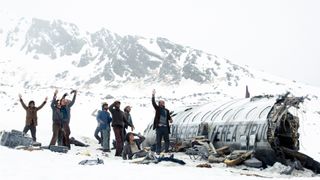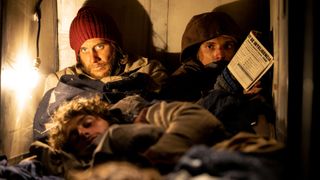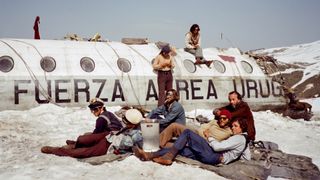Director J.A. Bayona talks bringing the harrowing true story of the 1972 Andes plane crash to life in new Netflix movie Society of the Snow
Exclusive: J.A. Bayona on collaborating with the survivors of the tragedy, filming at the site of the crash, and more

Netflix is no stranger to telling true stories (Maestro, Nyad, and Rustin are just three recent biopics released by the streamer), but Society of the Snow brings a new scale and scope to the genre.
The movie depicts the events of the 1972 Andes flight disaster, when a plane carrying 45 passengers from Montevideo, Uruguay, to Santiago, Chile, crashed in the South American mountain range. The survivors spent 72 days stranded in the mountains, braving avalanches, exposure, freezing temperatures, and high altitudes, eventually resorting to cannibalism to stay alive.
Directed by J.A. Bayona, whose previous offerings range from disaster movie The Impossible, about the 2004 Indian Ocean tsunami, to the second entry in the Jurassic World franchise, Fallen Kingdom, Society of the Snow is the filmmaker's first movie in his native Spanish since his 2007 debut, the horror film The Orphanage. We sat down with Bayona at Netflix's central London offices to discuss collaborating with the survivors of the tragedy, filming at the site of the crash, and more.
The following interview has been edited for length and clarity.

GamesRadar+: What drew you to this subject matter? Did you want to make more survival movies after The Impossible?
J.A. Bayona: I was never planning to do another survival film after The Impossible, but I remember that the book Society of the Snow was published as I was preparing to film The Impossible, and I read it and it hooked me. It really impacted me and also helped me understand what was going on in the minds of the characters in The Impossible. I was so impressed with the scope, the size of it, and on a spiritual, human, and philosophical level, it was even bigger than The Impossible. I was very impressed with the relationship in the book between the living and the dead. We already had the book and the film Alive that focused more on the story of the survivors, but this book focused more on what had happened.
Alive is a Hollywood movie, so did you think it was important to tell that story in the Spanish language and with a Latinx cast?
Sign up to the GamesRadar+ Newsletter
Weekly digests, tales from the communities you love, and more
I really wanted to tell the story in the most realistic and respectful way. To me, it was very important to capture the socio-political context of the time to understand how they behaved in the mountains – it's a story that you cannot tell without the context. And to me, starting with a different language would have spoiled that approach from the very beginning.
The book that your film is based on features interviews with the survivors, but your team also conducted their own interviews with them. What was that like?
We always felt very lucky that we were able to shoot this film with the collaboration of not only the survivors but also the families of the deceased, so I wanted to sit down with them and get as much information as possible. All the time on set, I had [Society of the Snow author] Pablo Vierci by my side, asking him specific questions about the culture, about the context, so I became obsessed with that in order to capture the reality. To me, it was very important to create this immersive experience that puts the audience into that plane and makes them feel what they went through. By doing that, you create a sense of empathy, and through that you can understand what they did. To me, that was the goal. That's exactly what Numa [one of the passengers, played by Enzo Vogrincic Roldán] is doing as the narrator: putting the audience in that situation so they can understand and accept what they were doing.
How did you navigate making a film where every character is a real person and everything that we're seeing actually happened? Was there any pressure there?
Normally, when you write a script, you try to make the story as cinematic and interesting as possible. But, in this case, I didn't want to change the real events, I really wanted to understand why they did what they did, because I think that's more interesting. We put the actors in contact not just with the survivors, but also with the families of the deceased, and they had the chance to be in constant contact with them, so if they had any questions, they were able to call and ask them.

Have any of the survivors seen the film and given their verdict?
Five days before the world premiere in Venice, I took a flight to Uruguay and I showed the film to all the survivors, the families of the survivors, and the families of the deceased, all together. We were very scared – not only us, but also them. They hadn't read a single line of the script, so they didn't know what to expect from the film. But, ultimately, I think the reaction was very positive. And I was very impressed to see people together for the first time in 50 years – suddenly they were there all together watching the film and hugging each other and crying. I was relieved, but the ones for sure who were more relieved were the survivors. I think they genuinely were very happy with the film.
What was it like filming at the site of the crash?
It's very difficult to access. We went there at the same time of year as when the plane crashed. You need three days to get used to the altitude, so it took us three days to get there. Most of the film was shot in a ski resort in Spain, so it gave me a good idea of what the place was like, and then we went two further times to shoot with the actors. We couldn't bring any heavy stuff there, no cranes, no dollies. It was like shooting a documentary. We had to be very careful. It was a dangerous place – we had some avalanches during the shoot.
The sound design really stood out to me in terms of how visceral a lot of the scenes were – they almost made me think of a horror movie. You have some experience making horror movies, so did that come into play at all?
When I talked to some of the survivors, fear was what fuelled them and kept them going. The fear of getting stuck there and never seeing their families again, so it was very important to get the audience to that place. Sound was a huge challenge because there were no elements that made any sound in the mountain. I remember talking to the sound designer and he told me it was probably the most difficult film he had ever done. There was only the plane and the wind, so keeping the movie rich in terms of sound was a huge challenge.
A scene that really stuck with me was when the survivors are listening to a radio broadcast, and they find out that the search for them has been called off – there's a real despair that comes through from the actors. What was that like to film?
It was very interesting to film because the lenses were kind of distorted. I shot with lenses that I'd never used before. I decided to shoot the film almost like a documentary, very realistic, but then there was something, just following my intuition, that became more weird and strange and bizarre. I remember one of the survivors told me: 'Reality is not enough, only dreaming.' I had that scene really clear in my mind. We shot a lot, as there was a lot of improvisation. I gave freedom to all the actors to behave the way they felt was right for the characters. I really like the sound in that scene – how the news [broadcaster] changed the subject and you start to hear a jingle from the radio, which is a way of telling the audience that the world has turned the page and they have been abandoned.
Society of the Snow is streaming now on Netflix. For more, check out our picks of the other best Netflix movies to add to your watch list.
I’m an Entertainment Writer here at GamesRadar+, covering everything film and TV-related across the Total Film and SFX sections. I help bring you all the latest news and also the occasional feature too. I’ve previously written for publications like HuffPost and i-D after getting my NCTJ Diploma in Multimedia Journalism.
Most Popular

